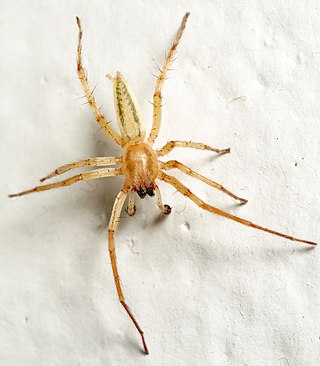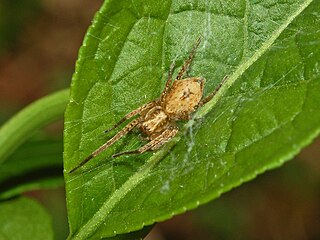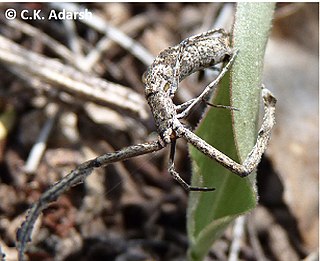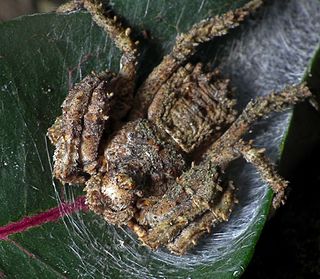
The Thomisidae are a family of spiders, including about 170 genera and over 2,100 species. The common name crab spider is often linked to species in this family, but is also applied loosely to many other families of spiders. Many members of this family are also known as flower spiders or flower crab spiders.

Anyphaenidae is a family of araneomorph spiders, sometimes called anyphaenid sac spiders. They are distinguished from the sac spiders of the family Clubionidae and other spiders by having the abdominal spiracle placed one third to one half of the way anterior to the spinnerets toward the epigastric furrow on the underside of the abdomen. In most spiders the spiracle is just anterior to the spinnerets.

The genus name is a combination of the Ancient Greek "argyros" (άργυρος), meaning "silver", and the suffix "-odes", meaning "like".

Thwaitesia is a genus of comb-footed spiders that was first described by Octavius Pickard-Cambridge in 1881.

Porrhothele antipodiana, the black tunnelweb spider, is a species of mygalomorph spider that lives in New Zealand. It is the most common and widespread of several species in the genus Porrhothele, and is especially common in the greater Wellington region where the vagrant mature males are often encountered in or around dwellings. This species is one of New Zealand's most studied spiders. In New Zealand, the common name "tunnelweb spider" is also often used to refer to members of the genus Hexathele. Neither should be confused with their distant relatives, the highly venomous Australian funnel-web spiders.

Anyphaena is a genus of anyphaenid sac spiders first described by Carl Jakob Sundevall in 1833.

Caponia, also called eight-eyed orange lungless spiders, is an Afrotropical genus of araneomorph spiders in the family Caponiidae, first described by Eugène Simon in 1887. As the common name implies, these spiders have a tightly arranged set of eight eyes, as opposed to the related two-eyed genus Diploglena, and breathe using two pairs of tracheae rather than book lungs. They are agile, nocturnal hunters, that hide by day in a variety of silk-lined retreats.
Acartauchenius is a genus of dwarf spiders that was first described by Eugène Louis Simon in 1884.
John Traherne Moggridge was a British botanist, entomologist, and arachnologist. A Fellow of the Linnean Society of London, he was known as a keen naturalist with great observational skills, as well as his paintings and illustrations. He wrote several articles on the fertilisation of plants, and his paintings of plants of southern France appeared in Contributions to the Flora of Mentone. His two volume study, Harvesting Ants and Trap-door Spiders, among other observations, confirmed that harvester ants are present in Europe, and was one of the first comprehensive treatments of the burrowing behaviour of trapdoor spiders. He was a correspondent of Charles Darwin, who cited his work in his books Fertilisation of Orchids and The Descent of Man, and Selection in Relation to Sex.

Ceraticelus is a genus of dwarf spiders that was first described by Eugène Louis Simon in 1884.

Miagrammopes is a genus of cribellate orb weavers first described by Octavius Pickard-Cambridge in 1870. These spiders have a unique shape and only four of their original eight eyes. They spin a single line of web, actively watching and jerking the line to catch their prey.
Cyrtognatha is a genus of long-jawed orb-weavers that was first described by Eugen von Keyserling in 1881. It is a senior synonym of Agriognatha. Species of this genus are found in The Americas.
Pterotricha is a genus of ground spiders that was first described by Władysław Kulczyński in 1903.
Ixchela is a genus of cellar spiders that was first described by B. A. Huber in 2000.
Pulchellodromus is a genus of running crab spiders that was first separated from Philodromus by J. Wunderlich in 2012.

Rhomphaea is a genus of comb-footed spiders that was first described by Ludwig Carl Christian Koch in 1872.

Stephanopis is a genus of crab spiders first described by Octavius Pickard-Cambridge in 1869. It was erected for five then newly described species, including S. altifrons, from Australia. Stephanopis was characterized by the high cephalic region with unequally sized anterior eyes disposed in a strongly recurved row, opisthosoma ending in several spiniform projections and dorsoventrally depressed habitus. According to Pickard-Cambridge, the single specimen used for the description of S. altifrons was dry-pinned. Therefore the specimen could not be properly examined, so it was not possible to determine if the specimen was adult. Moreover, he states his own sketch of the spider as “hasty” or "dull". This may explain why the somatic characters were inadequately described, genitalic features were not mentioned at all, and the illustrations were not detailed enough, making the species unidentifiable.
Josa is a genus of South American anyphaenid sac spiders first described by Eugen von Keyserling in 1891. It is a senior synonym of "Gayenella", "Haptisus", "Olbophthalmus", and "Pelayo".

Nemesia is a genus of mygalomorph spiders in the family Nemesiidae, first described by Jean Victoire Audouin in 1826.












